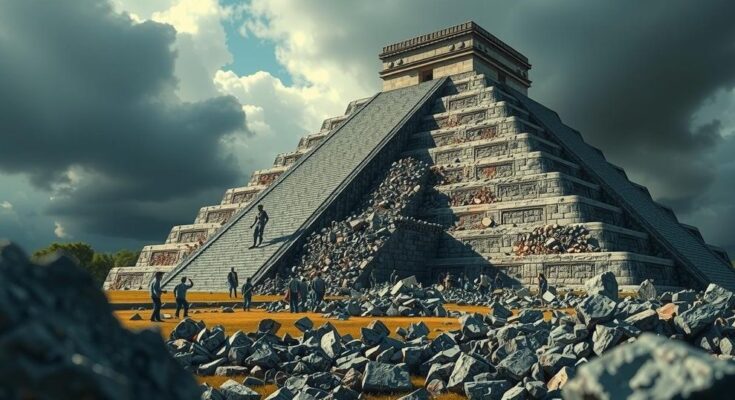In July 2024, a stone pyramid in Michoacán, Mexico, collapsed under severe rainfall, exemplifying the detrimental effects of climate change on cultural heritage sites worldwide. The incident, linked to extreme weather conditions following a significant drought, raises important questions about the preservation of archaeological artifacts. Members of the P’urhépecha tribe interpret the collapse as a “bad omen,” reflecting cultural significance in light of climate-induced disasters.
In July 2024, a stone pyramid in Michoacán, Mexico, collapsed after enduring relentless rainfall, marking a worrying display of the impact of climate change on cultural heritage sites worldwide. This 15-meter-high structure, once an awe-inspiring remnant of the Michoacán Kingdom civilization, succumbed to extreme weather conditions, highlighting a tragic outcome of increasing climatic chaos. The National Institute of Anthropology and History (INAH) reported that six other structures at the archaeological site are also suffering from deterioration due to similar weather extremes. The catastrophic event follows a prolonged drought, suggesting a direct connection between severe weather patterns and the integrity of ancient monuments. This collapse serves as a stark reminder of the vulnerability of historical sites in the face of climate change, which has resulted in severe weather events and rising seas affecting various global heritage locations. Notably, the damage sustained by this pyramid draws attention to broader concerns regarding the protection of archaeological artifacts as extreme weather continues to escalate. Not only does this event represent a loss of cultural heritage, but it also raises questions regarding the stewardship of these sites in an era marked by human-induced climate change. Archaeologists are compelled to adapt their preservation efforts to address these contemporary challenges, risking the legacy of human history in the process. Moreover, experts note a concerning trend of deterioration of other ancient artifacts globally, as exemplified by the deterioration of cave paintings in Oceania and recent studies highlighting the risks facing cultural heritage from increased precipitation. In regard to cultural interpretation, Tariakuiri Alvarez, a member of the P’urhépecha tribe, remarked that the pyramid’s collapse would have been perceived as a “bad omen” by his ancestors, who believed it signaled displeasure from the gods. This perspective connects the historical significance of the site to current events, illustrating a cultural lens through which to assess the implications of such disasters. Furthermore, days prior to the collapse of the Mexican pyramid, Utah’s iconic “Double Arch” also fell victim to changing environmental conditions, showcasing that not just one, but multiple heritage sites are under threat due to climate changes. The alarming frequency of such incidents demands urgent attention from global communities focused on the preservation of irreplaceable human history.
The ongoing impacts of climate change are increasingly jeopardizing historical heritage sites around the world. As severe weather events become more frequent due to human activities, many monuments are experiencing deterioration and structural failure. In Mexico, the recent collapse of a stone pyramid points to a broader crisis affecting archaeological preservation. This pyramid is not merely a relic; it represents the complex history and culture of the Michoacán Kingdom and the P’urhépecha civilization, both of which have enduring significance for contemporary society.
The collapse of the ancient pyramid in Michoacán serves as a powerful example of the vulnerabilities faced by cultural heritage sites in an era of climate change. As extreme weather events proliferate, the need for effective preservation strategies has become increasingly urgent. The loss of such historical monuments not only signifies a diminishment of cultural identity but also urges deeper reflection on humanity’s role in safeguarding the past for future generations. Analyzing these occurrences helps contextualize the importance of addressing climate change with urgency and responsibility.
Original Source: www.sciencealert.com




